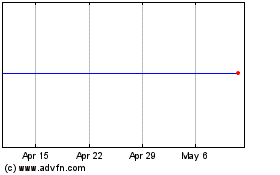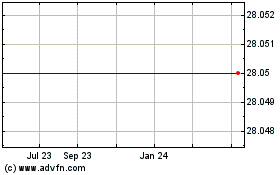By Mike Esterl
Big Soda has found a way to stem its losses: charge more for
less.
U.S. store sales of soda fell in terms of volume in 2015, but
dipped only 0.1% to $26.59 billion on a dollar basis for the 52
weeks ended Dec. 26. That is the best performance since 2012, when
value of sales were flat, according to the data service
Nielsen.
Some industry observers think dollar sales were even slightly
positive in 2015.
The improved performance comes as companies increasingly market
soda as a special treat, in part by steering Americans to smaller
7.5-ounce cans and 8-ounce bottles, but charging more per
ounce.
"Moms want to treat their kids, but they don't want them to have
too much," Sandy Douglas, North American president of Coca-Cola
Co., told investors at a November conference.
The strategy shift comes after companies failed to lure back
customers with price cuts through much of 2013 and 2014. Last year,
volumes fell again--2.2% according to Nielsen--marking the 11th
straight year of consumers cutting back over concerns about obesity
and artificial sweeteners.
More than 60% of Americans polled by Gallup last July said they
try to avoid soda. New U.S. dietary guidelines capped daily
consumption of added sugars at about 200 calories, roughly 40 fewer
calories than a 20-ounce bottle of regular Coke.
Industry leader Coke has been the most aggressive in pushing
smaller sizes to consumers. The company says sales of its smaller
packages--including 8-packs of 12-ounce bottles and 7.5-ounce
cans--rose 15% in the first nine months of last year. Meanwhile,
sales of larger bottles and cans fell to about 85% of its U.S.
sales last year from 90% in 2011, even though buying Coke in larger
quantities almost always costs less at the store.
Rival PepsiCo Inc. says industrywide sales of 12-ounce can
packs, half-liter and 2-liter bottles--which are often heavily
discounted--have fallen at an average annual rate of 2.6% since
2011. The company says sales of smaller packages, which typically
hold fewer ounces, increased 1.8% annually over the same
period.
At a Publix supermarket in Atlanta recently, a 12-pack of
12-ounce Coke cans was priced at $5.29, or 3.67 cents per ounce. An
8-pack of 7.5-ounce cans was priced at $3.99, or 6.65 cents per
ounce.
Fast-food chains are coping with the change in customer
preference by cutting prices. McDonald's Corp. and Burger King
Corp. earlier this month launched deals that were, in effect, more
food and soda for less money.
"You have to be careful to raise prices in this environment
because consumers are pinching pennies,"' said Jack Russo, a
consumer staples analyst at Edward Jones.
But so far the strategy is paying off for Coke, Pepsi and Dr
Pepper Snapple Group Inc., whose combined share of the U.S. soda
market tops 90%. They were able to raise soda prices 2% to 3% by
various estimates over the course of 2015. Usually when that
happens, cheaper private-label brands gain market share, but that
wasn't the case last year. Private-labels saw sales decline by 3%,
according to Morgan Stanley.
In some ways, the soda industry is returning to its early 20th
century roots, when bottles were typically about 6 ounces and pop
was a treat saved for a special occasion. It wasn't until 1976 that
7-Eleven Inc. launched the 32-ounce "Big Gulp"' at its convenience
stores.
Now, once again, American soda drinkers "want to consume less
but they still enjoy their favorite brands," said Marty Ellen, Dr
Pepper's chief financial officer. Dr Pepper is rolling out
7.5-ounce cans nationally this year, replacing 8-ounce cans it
launched as an alternative to 12-ounce cans. Each 7.5-ounce can
holds about 95 calories, compared with 150 calories for a 12-ounce
can.
Mr. Ellen represents the current thinking that charging
consumers more for less is sustainable "for the foreseeable
future," he says, because even at higher prices, soda is still a
"cheap treat."
The strategy also buys soda makers time to diversify further
into smaller but faster-growing categories like bottled water, tea
and energy drinks. PepsiCo derives half its sales from snacks and
is the market leader in sports drinks and teas. Last year, Coke
bought a stake in energy drink maker Monster Beverage Corp. while
Dr Pepper Snapple invested in Bai Brands, a coffee-fruit drink
brand, and Body Armor, a sports drink by startup BA Sports
Nutrition LLC.
Moms aren't the only ones willing to pay more for less. Stephen
Benda, a 31-year-old engineer and longtime Coke drinker, said he
has started drinking the 7.5-ounce cans instead of 12-ounce cans to
lose weight.
"When I do get a 12-ounce, I can tell it's a significant amount
more than I need," said Mr. Benda, who lives near Atlanta.
(END) Dow Jones Newswires
January 27, 2016 05:44 ET (10:44 GMT)
Copyright (c) 2016 Dow Jones & Company, Inc.
Keurig Dr Pepper (NYSE:KDP)
Historical Stock Chart
From Mar 2024 to Apr 2024

Keurig Dr Pepper (NYSE:KDP)
Historical Stock Chart
From Apr 2023 to Apr 2024
